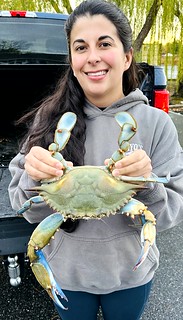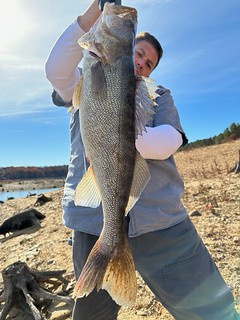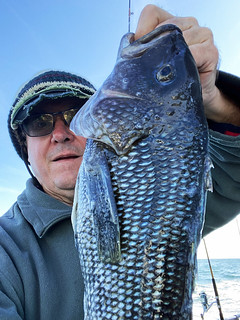Maryland Fishing Report – November 15

Sara LaMonica is all smiles with this large crappie she caught at Prettyboy Reservoir recently. Photo courtesy of Sara LaMonica
The weather is a bit chilly, but the fishing remains good. Anglers can be seen switching their footwear from sneakers to waterproof and insulated boots and warmer outdoor clothes.
Forecast Summary: November 15 – November 21:
The upcoming week should provide cool temperatures all week with windy conditions on Saturday. Surface water temperatures have dropped to the low 50s in the upper Chesapeake Bay, to the high 50s close to the Virginia state line. With Bay rivers running in the low 50s and high 40s, baitfish are moving out of the rivers to the warmer Bay waters. Salinity is average and there are suitable oxygen conditions down to the bottom in all areas of Maryland’s portion of the Bay.
Expect average flows in Maryland rivers and streams all week. There will be above average tidal currents through Friday as a result of the recent new moon on November 13. Expect average water clarity for most of Maryland’s Bay, rivers, and streams. To see the latest water clarity conditions, check Eyes on the Bay Satellite Maps.
As always, the best fishing areas could be further refined by intersecting them with underwater points, hard bottom, drop-offs, and large schools of baitfish.
For more detailed and up-to-date fishing conditions in your area of the Bay, be sure to check out Eyes on the Bay’s Click Before You Cast.
A lot of anglers are focusing on fishing for blue catfish in the lower Susquehanna River. The blue catfish are very active and there certainly are plenty of them to entertain anyone fishing with cut bait. Menhaden is the most popular bait, but gizzard shad and other fish species can work well. More anglers are discovering that not only do blue catfish provide a lot of fishing fun, but they are performing an important conservation responsibility by removing them from the Bay. As a bonus, they taste good when prepared properly.
Anglers are catching a few striped bass at the Conowingo Dam pool and the lower Susquehanna, but many are under the 19-inch minimum. Soft plastic jigs, paddletails, and lipless crankbaits are popular lures to use for casting. Anglers in the river are also targeting walleye and smallmouth bass, which are now more active due to the cooler water temperatures.
Striped bass have spread out throughout the upper Bay, and it can be tough at times to locate them. The channel edges at the mouths of the major tidal rivers are a good place to look for striped bass suspended off the bottom. Jigging with soft plastics and metal jigs is a popular way to fish for them. The Key Bridge, the Love Point rocks, and the mouths of the Chester and Magothy rivers are good places to check. A good depth finder is a valuable tool to locate suspended fish.
Trolling is an excellent option to fish the deeper channel edges for striped bass, but it can be difficult. Heavy inline weights of a pound or more are needed to get umbrella rigs down to the depths where the striped bass are holding. Stout trolling rods and reels, braided line, and a strong cranking arm are required to haul everything including the fish aboard. The edges of the shipping channel and channels leading from the major tidal rivers are good places to troll.
White perch in the tidal rivers and streams are moving deeper for slightly warmer waters. Most will eventually move to the deepest channel waters at the mouths of the tidal rivers or out in the Bay. Hard-bottom areas in the form of reefs, knolls, and oyster bottom are good places to find them. Bottom rigs baited with grass shrimp, pieces of bloodworm or artificially scented baits tend to work best.
Water temperatures are steadily declining and are now in the upper 50s in the middle Bay. Striped bass are feeling the urge to look for warmer waters and that usually means going deep; trolling is quickly becoming one of the most popular ways to fish for them. It is an effective way to get down deep where the striped bass are often suspended close to the bottom along channel edges. Pulling umbrella rigs behind heavy inline weights is what it takes to get down to the depths, stout trolling rods and reels along with braided line are necessary tools of the trade. A strong arm also helps when trying to reel in all this gear along with a fish.

Maryland’s striped bass season in the Chesapeake Bay continues through December 10 — anglers may may keep one striped bass per person, per day, with a minimum length of 19 inches and a maximum length of 31 inches. Photo courtesy of Herb Floyd
Striped bass can be found holding along the channel edges from the Gum Thickets and Bloody Point Light south past Buoy 83 and to the False Channel and the CP Buoy. The outside edge of Thomas Point, the area off Chesapeake Beach, and Breezy Point are also worth trying. A good depth finder is invaluable this time of the year for marking fish suspended in deep waters along the channel edges. The major channel edges outside of the region’s tidal rivers are staging areas for striped bass waiting for schools of juvenile menhaden to be swept along by strong currents. Most often an ebbing tide tends to ring the dinner bell for suspended striped bass as the baitfish are swept along by strong currents.
Light-tackle jigging with soft plastics and metal jigs is perhaps one of the most fun ways to fish for striped bass and certainly very exciting when breaking fish and diving gulls are part of the action. The mouth of Eastern Bay and the Choptank River are two of the most popular locations for this type of fishing, but it can occur almost anywhere in the region. If breaking fish are not present, gulls sitting on the water, slicks, and marks on a depth finder can help reveal striped bass feeding deep below the surface.
White perch are on the move to the deeper waters in the lower sections of the region’s tidal rivers as water temperatures in the tidal river drop to the low 50s. They can be located holding over oyster beds and similar hard bottom on depth finders. There are channel areas off Matapeake that are also great places to look for white perch. Bottom rigs baited with grass shrimp, pieces of bloodworm or small jigs on a dropper rig that are tipped with pieces of bloodworms or bloodworm-scented artificial baits. The rock piles at the Bay Bridge are known for holding large white perch this time of the year, small but heavy jigs are required to reach them due to strong currents.
Fishing for a mix of channel catfish and blue catfish in the tidal rivers is an option for anglers. Channel catfish can be found in every tidal river and blue catfish can show up occasionally. The Choptank River holds the greatest concentration of blue catfish, and they can be found from the Dover Bridge area to upriver of Denton. Cut baits of menhaden or other fish work well for baits on a bottom rig.

Rich Watts decided to go crabbing one last time recently and caught this 9-inch crab held by his daughter. Photo by Rich Watts
Trolling tends to be one of the more popular ways to fish for striped bass in the lower Bay. Striped bass are holding deep along the edges of channels in the lower Potomac River, the lower Patuxent, and the major steep channel edges in the Bay. In the Potomac River, a hot spot for anglers trolling umbrella rigs is the steep edges from St. Georges Island to Piney Point. In the Patuxent River, the steep channel edges off Broomes Island, Helens Bar, and Point Patience have been excellent places to find striped bass. At the mouth of the Patuxent, Cedar Point and Cove Point deep edges are good places to troll deep this week.
The cuts running through Hoopers Island are always a great place to cast soft plastic jigs and bucktails for striped bass. A lot of juvenile menhaden pour through those cuts and striped bass are usually waiting for them. The steep edges of the shipping channel from Buoy 76 south past Buoy 72B provide good trolling locations. There is also some jigging action for striped bass being reported at the Northwest Middle Grounds.
Umbrella rigs pulled behind heavy inline weights have been the most popular way to troll this week, but tandem rigged bucktails dressed with sassy shads or twistertails also work well. Jigging with soft plastic or metal jigs is a fun way to fish for striped bass when concentrations of them can be marked on depth finders. The channels at the mouths of the region’s tidal rivers are a good place to look for striped bass suspended near channel edges. With luck, one might encounter striped bass pushing menhaden to the surface, marked by diving gulls.
White perch have moved to the deeper waters in the lower sections of the region’s tidal rivers this week. There are numerous reports of excellent fishing for white perch in the lower Patuxent River. Similar fishing for white perch can be found in the lower St. Marys River, the Nanticoke and Wicomico rivers, and waters in Tangier Sound. Bottom rigs baited with grass shrimp, pieces of bloodworms, or artificial bloodworm-scented baits work well. Anglers can also use dropper rigs with one or two small flies or soft plastic jigs. Tipping them with a small piece of bloodworm or bloodworm scented baits will help entice the white perch to bite.
Fishing for blue catfish in the tidal Potomac, Patuxent, and Nanticoke rivers can be a fun and exciting venture this week. Cooler water temperatures are causing increased activity, so fishing is very good currently. Most cut fish will work well if it is fresh. Oily fish such as menhaden and gizzard shad tend to be the best, but white perch works well. Many anglers targeting large blue catfish will have success with live bait.
Most recreational crabbers have put their gear away for the season, but a few are setting their trotlines in deep water and coming up with some of the heaviest crabs of the year.
There is a category in the FishMaryland program where recreational crabbers catching crabs 8 inches or larger can receive an award certificate online. Visit the DNR website for details.

Scott Regan caught this beautiful 26-inch walleye recently at Triadelphia Reservoir. Photo courtesy of Scott Regan
The lack of rain this month is having a detrimental effect on many of the reservoirs in the western and central regions, and water levels are very low. In some reservoirs boat ramps are unusable. In those cases, good fishing can be found from shore or a kayak. Many streams and rivers are running low and clear, so stealth, light lines, and long casts are helpful. Leaves floating on the surface of streams and rivers can also offer pesky interference. Fishing for coldwater species such as smallmouth bass and walleye offers excellent fishing opportunities. The upper Potomac River is seeing water temperatures between 45 to 50 degrees this week.
There is plenty of fun trout fishing this week in the catch-and-release, delayed harvest, and fly-fishing-only waters. In the put and take waters, trout have spread out so covering a lot of water by casting small spinners and spoons is a good bet and offers a fun challenge.
Cooler waters are causing many freshwater fish to feed aggressively and move freely throughout the water column. Largemouth bass are roaming through a variety of habitats but the waters between the shallower areas and the deepest are good places to target largemouth bass. They will often be holding close to any kind of structure as they wait to ambush baitfish and crayfish migrating from areas of declining grass beds to deeper cover.
Spinnerbaits, jerkbaits, lipless crankbaits, soft plastic paddletails and craw jigs are all good choices for lures. When targeting sunken wood, fallen treetops and similar structure, wacky rigged worms can be a great lure choice if worked slowly.
Northern snakeheads are finding the waters a bit chilly this week and their activity is slowing down. Casting white paddletails near shoreline brush and sunken wood is still a good option. Fishing large minnows under a bobber is a great way to entice them to grab an easy meal. Sunny afternoons are a great time to fish the shallower areas exposed to the sun that helps warm the water.
Crappie are schooling up near structure in deeper waters this month. Marina docks, bridge piers, and deep sunken wood are all good places to look for them. Casting small minnows or marabou jigs under a slip bobber and allowing it to rest is a great way to target them in the fall.
Surf casters are still catching kingfish this week along with a mix of blowfish, flounder, and a few bluefish. Those fishing larger baits are catching dogfish, skates, and striped bass. There are a lot of large striped bass north of us in New Jersey, which hopefully begin to filter south along Maryland beaches.
At the inlet and Route 50 Bridge area, anglers are catching striped bass by casting soft plastic jigs and paddletails. Drifting cut bait is another option. Sheepshead are being caught along the jetty rocks, bulkheads, and bridge piers on sand fleas, while tautog are being caught on pieces of green crab.
The channels leading to the inlet are the place to fish for flounder as they use these pathways to the inlet for their fall migration offshore. The throwback ratio is reported to be high. Virginia researchers are surveying flounder anglers about their fishing habits and opinions. You can participate through the Virginia Tech website.
Anglers are enjoying some fun catch-and-release action for striped bass this week in the Ocean City Inlet and near the Route 90 and Verrazano bridges. Most of the striped bass are under the 28-inch minimum but they offer plenty of fun fishing. Casting paddletails and soft plastic jigs are the favored lures.
Anglers heading out to the offshore wreck and reef site continue to enjoy excellent fishing for black sea bass this week. Limit catches of fat sea bass are common along the rails this week. Anglers are also catching a few scup and flounder on the same trips. Anglers fishing in the canyons are targeting swordfish and both golden and blueline tilefish.
“I still don’t know why I fish or why other men fish, except that we like it, and it makes us think and feel.” – Roderick l. Haig-Brown
Maryland Fishing Report is written and compiled by Keith Lockwood, fisheries biologist with the Maryland Department of Natural Resources.
Click Before You Cast is written by Tidewater Ecosystem Assessment Director Tom Parham.
This report is now available on your Amazon Echo device — just ask Alexa to “open Maryland Fishing Report.”


 1-888-373-7888
1-888-373-7888 233733
233733